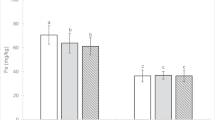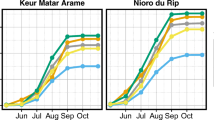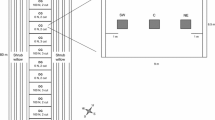Abstract
From 1986–92 alley cropping with Leucaena leucocephala (Lam.) de Wit and Cajanus cajan (L.) Millsp. was compared to a no-tree control, and fertilisation with 90, 39 and 75 kg ha−1 N, P and K vs. no fertilisation were studied in maize and cassava grown intercropped or in rotation. Light transmission measurements and row position effects on food crop yield did not indicate any decisive shading effect in tree-crop competition when trees were pruned 2–3 times a year. In the last three years, with NPK in solecropping the crop growth rates (CGR) of maize reached a peak of 100 g m−1 wk−1 around 70 days after planting (DAP). CGR in unfertilised Cajanus alleys was as high as in corresponding fertilised treatments but delayed by one month. For cassava, the highest growth rates of 60–130 g m−1 wk−1 lasted from 60 to 190 DAP with NPK in solecropping. The harvest index (HI) of cassaca reached 40–50% in all intercropping and unfertilised solecropping treatments. The HI in solecropping was reduced by fertilisation to 30–40% due to excessive leaf growth at 60–190 DAP. The increase in number of thickened roots starting at 30 DAP in solecropping was delayed by one month in intercropping. The reason for significantly higher cassava root yields in Cajanus alleys as compared to no trees in the fertilised solecrop was attributed to the enhanced root formation at 85 DAP due to a slower release of nutrients subject to leaching such as N and K from tree prunings than from mineral fertiliser.
Similar content being viewed by others
References
Akondé TP, Leihner DE and Steinmüller N (1996) Alley cropping on an Ultisol in subhumid Benin. Part. 1: Long-term effect on maize, cassava and tree productivity. Agrofor Syst 34: 1–12
Cock JH (1984) Cassava. In: Goldsworthy PR and Fisher NM (eds) The Physiology of Tropical Field Crops, pp 529–549. John Wiley and Sons Ltd., Chichester, UK
Cock JH and Howeler RH (1978) The ability of cassava to grow on poor soils. In: Jung GA (ed) Crop Tolerance to SuboptimalLand Conditions, pp 145–154. American Society of Agronomy, Madison, WI
Cock JH, Franklin D, Sandoval G and Juri P (1979) The ideal cassava plant for maximum yield. Crop Sci 19: 271–279
El-Sharkawy MA and Cock JH (1990) Photosynthesis of cassava (Manihot esculenta). Expl Agric 26: 325–340
Fischer KS and Palmer AFE (1984) Tropical maize. In: Goldsworthy PR and Fisher NM (eds) The Physiology of Tropical Field Crops, pp 213–248. John Wiley and Sons Ltd, Chichester, UK
Faukai S, Alcoy AB, Llamelo AB and Patterson RD (1984) Effects of solar radiation on growth and yield of cassava (Manihot esculenta Crantz). I. Canopy development and dry matter growth. Field Crops Res 9: 347–360
Handayanto E, Cadisch G and Giller KE (1995) Manipulation of quality and mineralization of tropical legume tree prunings by varying nitrogen supply. Plant Soil 176: 149–160
Hauser S (1993) Root distribution of Dactyladenia (Acioa) barteri and Senna (Cassia) siamea in alley cropping on Ultisol. I. Implication for yield experimentation. Agrofor Syst 24: 111–121
Howeler RH (1985) Potassium nutrition of cassava. In: Munson RT (ed) Potassium in Agriculture, pp 819–841. American Society of Agronomy, Madison, WI
IFA (1992) IFA World Fertilizer Use Manual. International Fertilizer Industry Association, Paris, France, 632 pp
Kang BT, Wilson GF and Sipkens L (1981) Alley cropping maize (Zea mays L.) and leucaena (Leucaena leucocephala Lam) in southern Nigeria. Plant Soil 63: 165–179
Karim AB, Savill PS and Rhodes ER (1991) The effect of young Leucaena leucocephala (Lam) De Wit hedges on the growth and yield of maize, sweet potato and cowpea in an agroforestry system in Sierra Leone. Agrofor Syst 16: 203–211
Kühne RF (1993) Wasser- und Nährstoffhaushalt in Mais-Maniok-Anbausystemen mit und ohne Integration von Alleekulturen (‘Alley cropping’) in Süd-Benin. Hohenheimer Bodenkundliche Hefte, Heft 13. Hohenheim University, Stuttgart, Germany, 244 pp
Sanchez PA (1995) Science in agroforestry. Agrofor Syst 30: 5–55
Sanginga N, Vanlauwe B and Danso SKA (1995) Management of biological N2 fixation in alley cropping systems: Estimation and contribution to N balance. Plant Soil 174: 119–141
Szeicz G, Monteith JL, dos Santos J (1964) A tube solarimeter to measure radiation among plants. J Appl Ecol 1: 169–174
Tian G, Kang BT and Brussaard L (1992) Biological effects of plant residues with contrasting chemical compositions under humid tropical conditions — decomposition and nutrient release. Soil Biol Biochem 24: 1051–1060
Author information
Authors and Affiliations
Rights and permissions
About this article
Cite this article
Leihner, D.E., Ernst-Schaeben, R., Akondé, T.P. et al. Alley cropping on an Ultisol in subhumid Benin. Part 2: Changes in crop physiology and tree crop competition. Agroforest Syst 34, 13–25 (1996). https://doi.org/10.1007/BF00129629
Issue Date:
DOI: https://doi.org/10.1007/BF00129629




